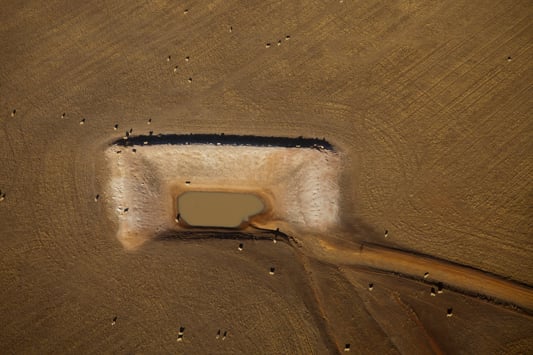The information here is for Western Australian conditions, particularly the dryland agricultural areas of the south-west and only a guide – seek expert advice before planning and use expert contractors for construction where necessary.
Roaded catchments are lined with clay and compacted to make a smooth surface that reduces infiltration and increases run-off. Roaded catchments should discharge into a silt trap and then into a dam (excavated earth tank). This combined structure should be fenced to exclude livestock.
The department recommends that roaded catchments are part of an integrated water and salinity management program.
Each landholder has a duty of care to make sure that flows from earthworks are not discharged indiscriminately on a neighbouring property and that stream flows are not significantly diminished or degraded.
See Conservation earthworks legal requirements of landholders for more information.
Need for improved farm water catchments
We recommend roaded catchments for all excavated earth tanks (farm dams) in the south-west of WA.
The south-west agricultural areas of WA have experienced a drying climate since about the year 2000, and the projection is for more dry seasons. These conditions increase the need for improved water harvesting into farm dams.
Reduced and lighter rainfalls have dramatically reduced run-off from cropped and pasture areas in most of the state, and minimum tillage cropping increases infiltration and reduces run-off even more. Constructing a roaded catchment for a dam is a cost-effective means of improving the performance and reliability of farm water harvesting.
Winter rainfall is often of low intensity in WA and falls of less than 10 millimetres (mm) per day are common. Continuous rain of up to 50 mm is generally needed to cause natural catchments to run water into farm dams. Therefore, building a roaded catchment to run water after less than 10 mm of rainfall greatly improves the catchment efficiency. With chemical treatment of the clay roads, the threshold for runoff can be as low as 4 to 6 mm.
For roaded catchments to work efficiently, good design and careful construction, followed by regular maintenance are very important. Before fitting a roaded catchment to an existing farm dam, assess the dam for place in the property, capacity and leakage. It may be better to build a new and larger dam, silt trap and roaded catchment in the right place.
- Depending on the surface treatment, there can be runoff from as little as 4 mm of rainfall or less.
- The area for this improved catchment is relatively small and does not affect the rest of a paddock’s use.
- Runoff has very low organic matter, nutrient and silt contamination.
- Needs expert design and construction to be most effective and durable.
- Should be fenced to exclude livestock. However, we recommend fencing the roaded catchment, a silt trap and the dam all in one.
- Needs occasional maintenance of the roaded surface.

